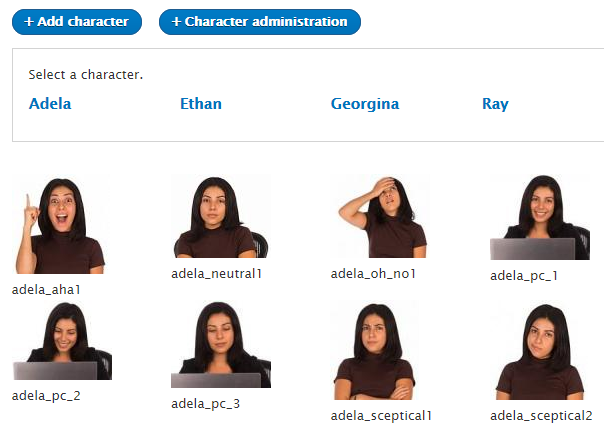Teaching tip
This page is part of a teaching tip from Oakland University's Center for Excellence in Teaching and Learning.
This is Adela.

Adela
Hello!
She's a pseudent, short for pseudostudent. Adela and her friends are in many of my lessons.
They each have different poses. For example:

Ethan
This is Ethan.

Ethan
This is Ethan, too.

Ethan
Another version.
I license the images from eLearningArt. There are other sources as well.
Psuedents are useful for written lessons in any field. Here are some ways I use pseudents.
Someone to explain to
When I'm explaining something, it helps to imagine a person I'm explaining it to. I imagine them asking questions, how I would respond, and what they might misunderstand. It could help with the expert's blind spot, where experts don't explain inferences that have become automatic for them.
Explicitly adding people to lessons makes them more real for me. It helps me keep potential emotional reactions in mind, too. Each psuedent has images of satisfaction, excitement, frustration, and so on.
Worked examples
Pseudents are great for worked examples, like this one of Ethan writing a simple program.
We know from the work of Sweller and friends how worked examples help with skill learning. The professor working through a task is a staple of the classroom.
There are issues, though. The professor is an expert, so will have implicit knowledge they don't have to think about. Imagining a novice working through a task might help with that.
The expert won't make many mistakes. This isn't just about expertise, but social pressure as well. Part of what it means to be an expert is to get things right, most of the time.
Having pseudents make mistakes removes that pressure. Watching pseudents detect, diagnose, and fix mistakes helps real students learn how to do it themselves.
Pseudents' struggles normalize difficulty. Experts make things look easier than they are. Pseudents fail, get frustrated, and ask for help. Real students learn that struggle is normal.
There's a problem with pseudent errors, though. When a pseudent makes a mistake, some real students won't detect it was an error. They might think it's the right way to do things. Even if the pseudent corrects the mistake later, what the pseudent did might have already been connected to other nodes in real students' memories, and be hard to remove.
Use annotations to mark pseudent errors when they occur. For example, this...
Note
Ethan made a mistake here. Try to find it.
... is from the worked example referenced earlier.
Just as real students might not notice pseudent errors, they might not notice when pseudents do something clever. Annotate those, too:
Note
Ethan is writing the code backwards. That's a great idea! Start with what you want the program to output, and work backwards towards the input.
You can use annotations to normalize difficulty as well:
Note
Programming is frustrating, since computers are so stupid. What Ethan's going through is normal. Even for me, and I've been programming for decades.
Notice the "me" and "I." There's an authorial identity in my lessons, writing from a personal perspective.
Models
Pseudents model the way I like real students to act. They ask challenging questions, but are always respectful. They are skeptical, but not rude. They help each other:

Ethan
Oh, I see it, Adela! You put the data for feet into the inches variable, and inches into feet. Easy mistake to make.
They show good learning practices:

Ray
Yeah, thanks G! I get it now.

Georgina
You're welcome. It helps me understand things better when I explain them to other people.
Stereotypes
Pseudents can oppose social stereotypes. For example, imagine what an excitable geek looks like. Got it in your head meat? Good.
Here's the excitable geek in my courses:

Georgina
Ooo! Ooo! C# delegates make pubsub so easy! Decoupling for the win!
Hmm, not what "excitable geek" brings to mind, for many people. But, yes, women can be excitable geeks, too.
eLearningArt has people from every demographic. You can make them what you want, not what people expect.
This online textbook
The page you're reading is in an online textbook for an introductory programming course for business students. Many of the lessons use pseudents. You're welcome to check them out.
The software used to create this site has special features for using pseudents. Here's an administration screen:

However, they're just regular images. They can be used in Moodle, WordPress, Drupal, Microsoft Word... anywhere you can insert images.
Summary
Psuesdents are fake students I add to lessons. They ask questions, work through examples, model good behavior, and challenge stereotypes. Most importantly for me, they help me remember to write explanations for novices.